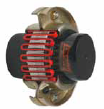The following details is necessary when generating a Grid coupling assortment:
Description of motor or engine, the horse electrical power (or KW), and RPM at slowest coupling pace whilst under load
Description on the driven equipment
Shaft and keyway sizes and also the form of fit for driver and driven equipment (clearance or interference)**
Shaft separation (BSE)
Physical room limitations (see Application Worksheet)
Identify what the environmental situations is going to be, this kind of as temperature, corrosive situations, interference from surrounding structures, and so forth.
By default, sizes 1020 – 1090 will probably be clearance match, sizes 1100 – 1200 will be interference match.
** Machines all bores and keyways to meet the dimensional and tolerance specifications per ANSI/AGMA 9002-B04 for inch bores, or ISO 286-2 for metric bores.
Common grid couplings consist of two grid hubs, a grid spring, plus a cover assembly. When the shaft separation involves a spacer fashion coupling, the coupling will include two shaft hubs, two spacer hubs, a grid spring, and also a horizontal cover assembly.
Formulas Utilised To Determine Torque:
Application Torque (in-lbs) = ( horse power x 63025 ) /RPM
Application Torque (Nm) = ( horse energy x 9550 ) /RPM
Variety Torque = Application Torque x Services Component
Higher Peak Loads and Brake Applications
For applications where substantial peak loads or substantial braking torques could be current, the next additional information and facts will likely be required:
Program peak torque and frequency
Duty cycle
Brake torque rating
The choice torque formula is much like the formula shown above except that the application torque really should be doubled prior to applying the service element.
Application Torque (in-lbs) = ( horse energy x 63025 ) /RPM
Application Torque (Nm) = ( horse energy x 9550 ) /RPM
Choice Torque = two x Application Torque x Service Component
Ways In Picking A Grid Coupling
Step one: Decide the application torque utilizing the formula proven over.
Stage 2: Select the Service Issue through the charts .
For applications  not displayed use the chart proven to the appropriate. Determine the Choice Torque working with the formula shown above.
not displayed use the chart proven to the appropriate. Determine the Choice Torque working with the formula shown above.
Step three: Employing the selection torque as calculated, refer on the Effectiveness Chart
Step four: Compare the utmost bore to the dimension picked and ensure the essential bore sizes don’t exceed the utmost allowable. If the expected bore dimension is larger, stage up to the subsequent dimension coupling and check out to discover if your bore sizes will fit.
Stage 5: Using the chosen coupling size, assess the bore and keyway sizes
Phase six: Make contact with your local industrial supplier with all the component numbers to area sizes together with the charts for UPC element numbers.